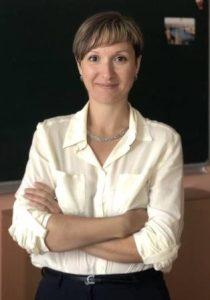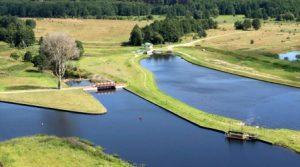Разработанный автором дидактический материал может быть использован в 10-11-х классах общеобразовательных школ в рамках изучения таких тем, как «Республика Беларусь», «Искусство» с целью развития коммуникативной и социокультурной компетенции учащихся через изучение историко-культурного наследия Республики Беларусь, воспитания у учащихся чувства патриотизма, углубления знаний учащихся об истории и культуре родного края.
 Людмила СИДОРЕНКО,
Людмила СИДОРЕНКО,
учитель английского языка,
ГУО «Средняя школа № 41 имени А.М.Кузнецова г. Гродно»
Introduction
Grodno is one of the oldest settlements in Belarus. It history goes back centuries. The settlement “Goroden” was first mentioned under the year 1127 in the Radziwill and Laurentian chronicles. However, the year of the city’s foundation is considered to be 1128. This date was first shown by the historian Evstafy Orlovsky in his book “Grodno Antiquity” which was based on the data of the Ipatiev chronicle. Goroden was mentioned as a military fortification on the very edge of the Ancient Russian state.
During its long history Grodno was a part of many States: the Grand Duchy of Lithuania (W. gender. XIII century — 1569), the Polish-Lithuanian Commonwealth (1569-1795 years), the Russian Empire (1795-1917 years), the German occupation (1918), Poland (1921-1939 years), the USSR( 1939-1991 gg.).
Each of these periods left its own unique mark in the history and architecture of the city. The city experienced periods of the highest prosperity (it was the residence of the kings of the Polish-Lithuanian Commonwealth) and decline (with the inclusion of the city into the Russian Empire).
The study of the architectural monuments is an integral part of our history that teenagers should know. It is important to have an idea of the beauty that our country, our city has. Nowadays Grodno is a tourist visa-free center where a huge number of tourists come. Knowing the history of our city helps students to understand the culture and development of our country, love and appreciate our city and country, allows us to understand our past which in turn allows us to understand our present. History helps to learn from the mistakes of the past, to preserve and transmit our values and traditions, to share our knowledge with tourists.
1. Read the description and guess the place.
The garden was created on April 8, 1775 and was a visual teaching aid at the academy. Three years after the founding of the garden, it was considered the best in Europe and included many different plants, namely 2000 species, many of which were rare.
When Gilibert had to leave the city, the care of the garden passed into the hands of the city authorities. Unfortunately they were unable to take care of the garden properly and the park was abandoned. In the 1920s, it was decided to recreate the botanical garden. (Gilibert Park)
The appearance of this church in the city is associated with the activities of the Jesuit monks in Grodno, who were invited by King Stefan Batory. The architectural and artistic merits of the Church put it on a par with the most striking masterpieces of the Baroque style in the world. In 1725, a mechanical tower clock was installed in the North Tower of the church, which had previously been on the city hall, which was destroyed during the war of 1654-1667. This clock is the oldest working tower clock in Europe. (Church of St. Francis Xavier)
It was built in the last quarter of the 18th century and is considered the oldest surviving theatrical building in Belarus. It is interesting that Emperor Alexander I himself had a hand in the improvement of the place. In 1802, during the celebration on the occasion of the creation of the Grodno province, plaster fell down. Alexander I immediately allocated 2,000 rubles for the repair of the theater building — a considerable amount for those times. Today this place in Grodno is one of the best in the country. Its repertoire includes over 50 performances for adults and children, and the ancient walls of the building create a special atmosphere that makes you return there again and again. (Puppet theater)
2. Answer the questions using QR-codes.
1. What is the name of the first church of the city?
2. Who founded several manufactories in Grodno and its environs?
3. What animal is depicted on the coat of arms of Grodno?
4. What building is more than 300 years old?
5. Where is the oldest clock located in Grodno?
6. What famous film are dedicated to Grodno?
7. Where did Stefan Batory live?
8. What is the name of the first theater in Grodno?
9. What is the name of the building?
10. Where is «Gorodnichanka» installed?

3. Do you know Grodno?
Choose between 2 positions.
1. What is the name of the largest artificial reservoir of the city? (Jubilee Lake/Lake Sinka)
2. What is the name of the staircase going down from the Old Castle to the Neman river? (The Ladder of Worship/Ladder of Love)
3. Where is the Borisoglebskaya Church located? (on the bank of the Neman/ the Gorodnichanka)
4. Where is the Mikhailovsky Bridge located? (Yanka Kupala Avenue/Ozheshko Street)
5. When did the first bridge across the Neman River appear in Grodno? (In the XV century/In 1907)
4. Guess the place in the picture
 |
 |
 |
 |
 |
 |
 |
 |
 |
 |
1. Drama Theatre.
2. The Old Castle.
3. St. Francis Xavier Cathedral.
4. The New Castle.
5. Kalozha Church.
6. House-Museum of M. Bogdanovich.
7. Sovetskaya Street.
8. Gilibert Park.
9. Augustow Canal.
10. Water towers Kasya and Basya.



 Предложить публикацию
Предложить публикацию